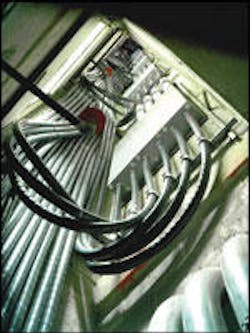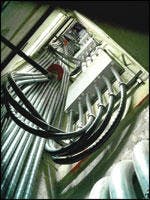Air-blown fiber carving larger niche in North America
By ROBERT PEASE
Over the past 10 years, air-blown optical fiber (ABF) has become a popular technology all over the world, with one major exception: North America. Reasons for the slow acceptance of ABF in the world's largest market vary, but this unique fiber deployment method is beginning to gain newfound interest for some applications. With recent technological advances, increased awareness through pumped-up marketing campaigns, and impressive benefits in both cost and ease of installation, this technology could quickly gain momentum.
Invented in Europe by British Telecom (BT-London) and first used in the early 1980s, the process involves the deployment of tube cable in place of traditional innerduct work. Tube cables may contain several individual tube cells inside a protective outer jacket. Once the cables are in place, fiber is blown through the tubes at speeds up to 150 ft per minute with minimal labor.
Flexibility is a key element, since the blowing methods and tube designs allow additional fiber to be quickly deployed in an existing network. It also enables changes and upgrades to existing networks by allowing fiber to be blown out, rerouted, and blown back into the new configuration. The process is simple, fast, and less expensive than traditional methods of pulling new fiber cable.Holding the patent on ABF technology, BT eventually began granting licenses to companies for blowing fiber into structures for LANs and other premises networks. Today, it is a popular method for achieving fiber-to-the-home (FTTH), -business, and -desk in Europe. For example, Ericsson Cables AB (Stockholm) recently deployed its Ribbonet ABF technology in an FTTH project connecting 824 apartments in a residential area in Hudiksvall, Sweden. But the company also foresees more business application opportunities, as corporate customers require more network flexibility.
"Where data equipment and personnel move around a lot, bandwidth and connectivity must be easy to reallocate," says Christian Kimell, product-line manager at Ericsson Network Technologies. "Another customer group interested in ABF technology is the BLEC [building local-exchange carrier] who will leverage on the 'pay as you grow' scenario with a low upfront investment."
Kimell believes the European market has seen a much deeper penetration of fiber, while the United States has been lagging in bringing broadband to the subscriber. European operators, network owners, and property owners may be a few years ahead in optimizing their access network and working on their business scenarios.
With most ABF suppliers based outside the United States, the focus over the last several years has been primarily on the European market. The limited number of vendors working with ABF in the U.S. has created a noncompetitive pricing environment, perhaps putting systems just out of reach of potential customers in terms of affordability.
Emtelle International (London), another worldwide provider of ABF systems, agrees that in today's challenging markets, achieving the lowest possible construction costs will eventually be the advantage that propels ABF's acceptance in North America. The company's "fiberflow" approach has been successfully used in such facilities as Norway's underground railway system, tall business buildings in Africa and Singapore, and a major bus route as well as the Sydney harbor bridge in Australia. Emtelle also believes the North American market will eventually embrace ABF.
"Cost deferral and futureproof flexibility used to be the real advantages to blown fiber," says Dr. John Lupton, managing director at Emtelle. "With lowest initial build in our list of advantages, flexibility and cost deferral are simply icing on a newer, lower-cost cake."
The two companies most responsible for developing ABF awareness in North America are Sumitomo Electric Lightwave (Research Triangle Park, NC) and General Cable Technologies Corp. (Highland Heights, KY), both licensed to manufacture and deploy ABF in the United States. The companies have different philosophies that are reflected in their products.
Sumitomo's FutureFLEX fiber cabling system is the first multifiber, bundled air-blown system for LAN applications in North America. It provides microbundles of 6, 12, and 18 fibers in a standard backbone-riser approach as well as fiber pairs for the horizontal to the desktop. Sumitomo recently introduced two new advances in its system: an air-blown aerial cable innovation for its FutureFLEX system and a new generation of tubing, FLEX HP, that reduces friction in the inner tube to allow increased blowing distance for longer installations. Distances of up to 2 km per blowing head can be achieved with a total installation capacity of 342 fibers in a 19-tube cable.
General Cable blows individual fibers-up to eight per microduct-to provide additional mix-and-match flexibility in installation.
There have also been improvements made in reducing labor, on-demand fiber capabilities, connectivity products, and combining duct and power/utility cabling. The decrease in price for active components like media converters, setup boxes, and switches has helped to further lower installation costs. Armed with these and other technology advances, the gospel of ABF is being preached throughout North America-and the congregation is all ears.
"I suspect ABF is slowly catching on because of the generally increased interest in fiber and increased marketing attention by both General Cable and Sumitomo," says Paul Bishop, president and chief engineer of Bishop Group Inc., a professional engineering services company that provides introduction and application of new technology for early adopters. "More people are becoming familiar with it, especially government and institutional users where costs can be deferred by installing tube now and blowing fiber later."
Bishop believes the United States may have to overcome a "not invented here" attitude that has evolved into a mindset of only being interested in the latest well-known infrastructure at the lowest possible cost. Instead, designers must look at advantages inherent to ABF and focus on the customer's needs and plans for future growth.
"We ask our clients to provide a vision of where they think they'll be in five years and use that to modulate the design," says Bishop. "We document their needs so we have a set of traceable requirements to support the design. Many clients don't think that far out, and that limits the growth of ABF. Another reason ABF has delayed taking off in the U.S. is simply because most end users, owners, and managers remain uninformed of the value added by installing air-blown optical fiber."
Sumitomo may be making the most impact in the United States with its marketing machine working full speed to sing the praises of ABF. However, the real proof of the acceptance of ABF can be seen in the growing number of applications across the country-and the advantages they provide to the customer.
For example, the University of Utah had to re-deploy its telecommunication assets to another facility. Its ABF system enabled the university to simply blow out fiber bundles from the old site and reuse them at the new site-an easy task and a cost-saving advantage of ABF.
Other significant customers include ESPN (Bristol, CT), which has a need for a scalable, high-bandwidth infrastructure for future hard-to-predict demand. The Pentagon and other government entities are using ABF primarily because of minimal worksite disruption, point-to-point installation, and the flexibility to make changes to its enterprise network to accommodate such applications as increased security measures.
Within the automobile industry, ABF has been standardized in over 80 manufacturing facilities throughout the United States, Canada, and Mexico. Sporting events such as Road America and the Atlanta Motor Speedway also find ABF appealing for its scalability, speed, and ease of installation and dismantling for sporting events.
"Since there are far more companies that do not endorse blown fiber technology due to the direct competition it presents to their conventional fiber cables, ABF technology is relatively unknown by the masses," says Keith Quistorff, product marketing manager for Sumitomo's Enterprise Markets Group. "This is a major hurdle that we are working to overcome by communicating the unrivaled features and benefits of ABF directly with many end-user organizations. Response to this information has been overwhelmingly positive, and we look forward to continued growth through communication."
Sumitomo and others expect the North American market for ABF to be very strong over the next few years. ABF has the potential to work hand-in-hand with other relatively new technologies like passive optical networks (PONs). For short distances, such as those used for PONs, ABF has high potential value, say advocates-just put in the tubes now and provision with fiber quickly and economically in the future.

